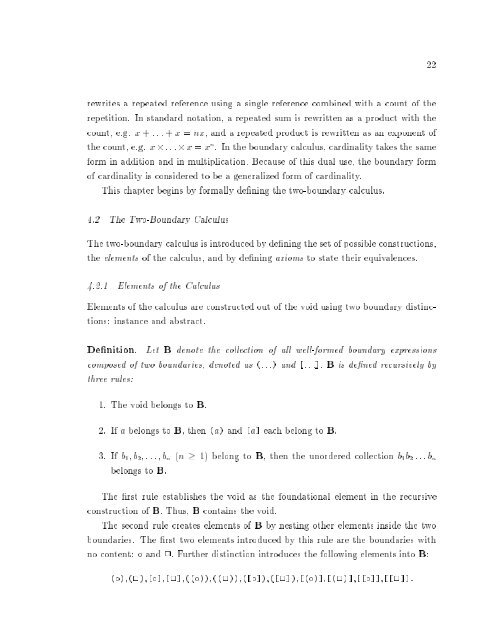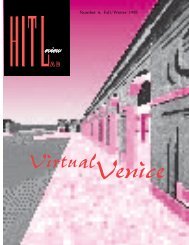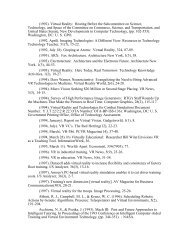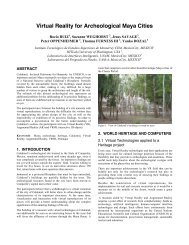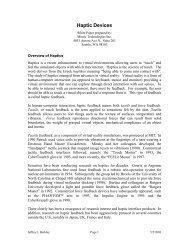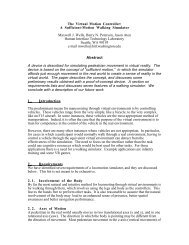A Calculus of Number Based on Spatial Forms - University of ...
A Calculus of Number Based on Spatial Forms - University of ...
A Calculus of Number Based on Spatial Forms - University of ...
Create successful ePaper yourself
Turn your PDF publications into a flip-book with our unique Google optimized e-Paper software.
22<br />
rewrites a repeated reference using a single reference combined with a count <str<strong>on</strong>g>of</str<strong>on</strong>g>the<br />
repetiti<strong>on</strong>. In standard notati<strong>on</strong>, a repeated sum is rewritten as a product with the<br />
count, e.g. x + :::+x = nx, and a repeated product is rewritten as an exp<strong>on</strong>ent <str<strong>on</strong>g>of</str<strong>on</strong>g><br />
the count, e.g. x :::x= x n . In the boundary calculus, cardinality takes the same<br />
form in additi<strong>on</strong> and in multiplicati<strong>on</strong>. Because <str<strong>on</strong>g>of</str<strong>on</strong>g> this dual use, the boundary form<br />
<str<strong>on</strong>g>of</str<strong>on</strong>g> cardinality is c<strong>on</strong>sidered to be a generalized form <str<strong>on</strong>g>of</str<strong>on</strong>g> cardinality.<br />
This chapter begins by formally dening the two-boundary calculus.<br />
4.2 The Two-Boundary <str<strong>on</strong>g>Calculus</str<strong>on</strong>g><br />
The two-boundary calculus is introduced by dening the set <str<strong>on</strong>g>of</str<strong>on</strong>g> possible c<strong>on</strong>structi<strong>on</strong>s,<br />
the elements <str<strong>on</strong>g>of</str<strong>on</strong>g> the calculus, and by dening axioms to state their equivalences.<br />
4.2.1 Elements <str<strong>on</strong>g>of</str<strong>on</strong>g> the <str<strong>on</strong>g>Calculus</str<strong>on</strong>g><br />
Elements <str<strong>on</strong>g>of</str<strong>on</strong>g> the calculus are c<strong>on</strong>structed out <str<strong>on</strong>g>of</str<strong>on</strong>g> the void using two boundary distincti<strong>on</strong>s:<br />
instance and abstract.<br />
Deniti<strong>on</strong>.<br />
Let B denote the collecti<strong>on</strong> <str<strong>on</strong>g>of</str<strong>on</strong>g> all well-formed boundary expressi<strong>on</strong>s<br />
composed <str<strong>on</strong>g>of</str<strong>on</strong>g> two boundaries, denoted as(:::) and [:::]: B is dened recursively by<br />
three rules:<br />
1. The void bel<strong>on</strong>gs to B.<br />
2. If a bel<strong>on</strong>gs to B, then (a) and [a] each bel<strong>on</strong>g to B.<br />
3. If b 1 ;b 2 ;:::;b n (n 1) bel<strong>on</strong>g to B, then the unordered collecti<strong>on</strong> b 1 b 2 :::b n<br />
bel<strong>on</strong>gs to B.<br />
The rst rule establishes the void as the foundati<strong>on</strong>al element in the recursive<br />
c<strong>on</strong>structi<strong>on</strong> <str<strong>on</strong>g>of</str<strong>on</strong>g> B. Thus, B c<strong>on</strong>tains the void.<br />
The sec<strong>on</strong>d rule creates elements <str<strong>on</strong>g>of</str<strong>on</strong>g> B by nesting other elements inside the two<br />
boundaries. The rst two elements introduced by this rule are the boundaries with<br />
no c<strong>on</strong>tent: and 2: Further distincti<strong>on</strong> introduces the following elements into B:<br />
();(2);[];[2];(());((2));([]);([2]);[()];[(2)];[[]];[[2]]:


